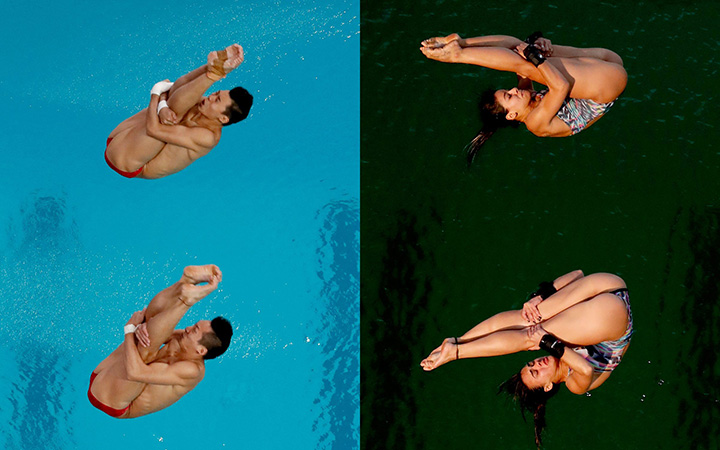Water issues are once again raising questions over the health and safety of athletes at the Rio Olympics after the pool water at the Olympic diving venue turned green overnight.

During the women’s 10m synchronized diving final on Tuesday afternoon, the pool water appeared to be murky and green after the event began at the Maria Lenk Aquatics Centre.
Those who were watching the competition were quick to take to social media to question what exactly happened to the water quality.
Though, at first, Olympics officials did not comment on the colour of the water, but many speculated the water issue had to do with chlorine and pH balancing of the pool. Cloudy pool water could also be the result of a bad filtering system.
READ MORE: Meaghan Benfeito and Roseline Filion win synchronized diving bronze
According to Cassidy Franks, operations manager at Toronto-area swimming pool design and installation company Pool Craft, the water discolouration is most likely due to a chlorine imbalance, resulting in the presence of algae.
“It’s basically the chlorine in the water… if it doesn’t have the chlorine in the water or if there’s a filtration issue where it’s not filtering the pool and turning over the water then that’s also going to cause the pool to turn from blue to green,” Franks said.
Franks explained the discolouration is an indicator of algae growth.
“The lack of chlorine allows the algae to feed on the oils, people’s skin, sweat…it can turn (colour) that quickly very easily,” Franks explained. “Especially if there’s a high volume of bathers in the pool, if you have a high bather load in the pool then within a couple of hours, if that pool is not being treated properly, then that can definitely cause the pool to turn green very quickly.
Franks explained that warm temperatures would also be a factor in the growth of algae.
“On warmer days the chlorine would definitely be used up quicker,” Franks said. “The warmer the water is the more it’s exposed to the sun…the hotter that it is the faster the chlorine burns off. So, if you’re not consistently having a slow release of an amount of chlorine put in the pool to accommodate for the high bather load and high temperatures, then within a day you could see it turn from blue to green.”

Get breaking National news
Franks also suggested that the pool’s pump could play in as a factor.
“Running the pump consistently for 24 hours a day, if at any time the pump is shut off or the power goes out, then because the pool is not circulating and is sitting stagnant it can also cause the pool to start going green,” Franks said.
Canada’s diving team leader Mitch Geller also suspected the cause was algae that multiplied quickly in the day’s warm and sunny conditions.
“Everybody was scratching their heads going, ‘What’s going on?”‘ he said. “I think that the filter is busted, but I’m not sure. It’s not really dangerous. It’s not like it’s toxic or dirty or any of that. It seemed to get worse over the course of the competition.”
Canada’s bronze medallists Meaghan Benfeito and Roseline Filion tried not to laugh as they gazed at the water from atop the 33-foot tower. They liked that the dark green colour offered a helpful contrast with the blue sky.
“The only thing we said is don’t open your mouth in the water, just in case,” Benfeito said.
As for a health concern for swimmers, Franks said the lack of chlorine and if the pool is not treated, it could become a health problem.
“It’s nothing that would pose as an immediate threat but if it’s left like that and neglected then it definitely could,” Franks said.
According to Toronto’s medical officer of health, pool water should have a minimum chlorine or bromine concentration of 2.0 parts per million and a pH level between 7.2 – 7.8.
Rio organizers said water tests were conducted and there was no risk to athletes.
The green water mystery comes on the third day of diving events at the venue with another 10 days of events to come.
–with files from The Associated Press






Comments